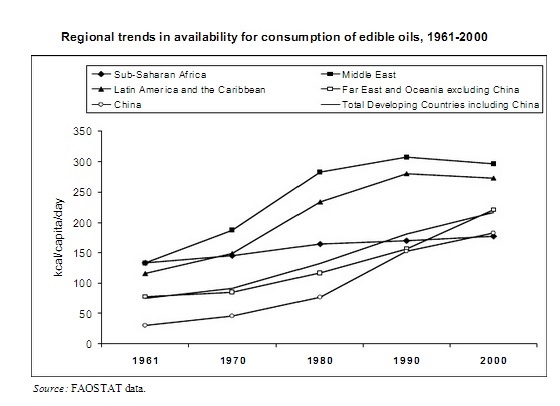Post-modern
Now we live in an era of laziness and we want the things for the day before today, meaning that we want everything, at every moment and with no care of social nor environmental repercussions.
Urbanization, as result of the huge growing population, creates a new and improved marketing and distribution infrastructure, attracts supermarkets and their sophisticated food handling systems (cold chains, etc.), better roads and ports, thus improves the access of foreign suppliers and the importance of imports in overall food supply and, all in all, promoting a globalization of dietary patterns [44].
Most importantly from a nutrition perspective, these changes include not only a shift towards higher food energy supplies but also a shift towards more fats and oils and more animal-based foodstuffs, and thus higher intakes of saturated fat and cholesterol [45].





Figure 8. Regional trends in availability for consumption of different sources: animal food, edible oils, fruits and vegetables, sweets and total calories between 1961-2000. From [1]
Urbanization is also often associated with less physical labour, a mechanization of production, and the convenience of piped water or mechanised transportation. In general it leads to a more sedentary lifestyle with calorie expenditures that are 10-15% below rural averages [46].
Our society’s view of the body as a machine, at our disposal for the means of productivity, and our food as fuel to power that productivity, has brought about serious illness—obesity and eating disorders, which affect not only physical health, but also identity. The technology we have developed to improve our own control and comfort now defines us. It directs our goals, our actions, and our nourishment. Even eating is no longer acknowledged as an “agricultural act,” as farmer-poet Wendell Berry calls it. In a new-age essence to eating, we rarely see our plate’s connection to the earth and elements; our experience with food is “passive and uncritical.” [47].
All this changes (diet and lifestyle) occurred to fast for the human genome to adjust and this led the emergence of the so-called diseases of civilization. In particular, food staples and food-processing procedures introduced during the Neolithic and Industrial Periods have fundamentally altered 7 crucial nutritional characteristics of ancestral hominin diets [34]:
- glycemic load
- fatty acid composition
- macronutrient composition
- micronutrient density
- acid-base balance
- sodium-potassium ratio
- fiber content.
To know more about this you can read the article here.
